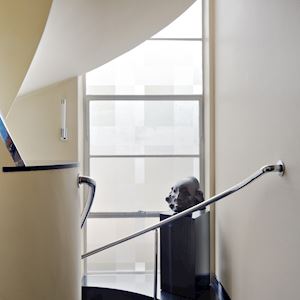
03. Staircase and first-floor landing
The magnificent ornamental staircase almost seems to carry you upstairs. Its broad steps are clad in black marble from Namur in Belgium, with strips of rubber to deaden the noise. The best view of the whole structure is from the first floor. The staircase spirals up through the whole house like a screw, with an open central axis and gleaming chrome bannisters continuing the serpentine movement. The daylight is beautifully diffused by the matt glass windows with patterns of squares and rectangles etched into them. You’ve just gone past a bronze mask, hanging on the stairwell wall. It was designed by the sculptor John Rädecker, who is known in particular for his work on the National Monument on Dam Square in Amsterdam. In the nineteen thirties, Rädecker was seen as one of the leading sculptors of his time. It is not clear who this mask represents, if anyone. Is it the face of Gé, the youngest daughter of the Sonnevelds, or was someone else the model for this mask? The ‘lion’ in the living room is also by John Rädecker. You’ll be seeing that shortly. The first-floor landing is quite simple, with only the colours of the doors providing variety: grey for cupboard doors, and light yellow for those leading into the rooms. The door to the sitting room is at the far end of the landing.
You can still see parts of the original paint on the wall, just underneath the ceiling at the top of the stairs. If you'd like to know more about this, press A.


Sonneveld House is one of the best-preserved houses in the Dutch Functionalist style. The villa was designed in 1933 by architecture firm Brinkman and Van der Vlugt for Albertus Sonneveld, a director of the Van Nelle Factory.
- Museumpark 25
- Rotterdam Netherlands
- 010 440 1200
- nieuweinstituut.nl
